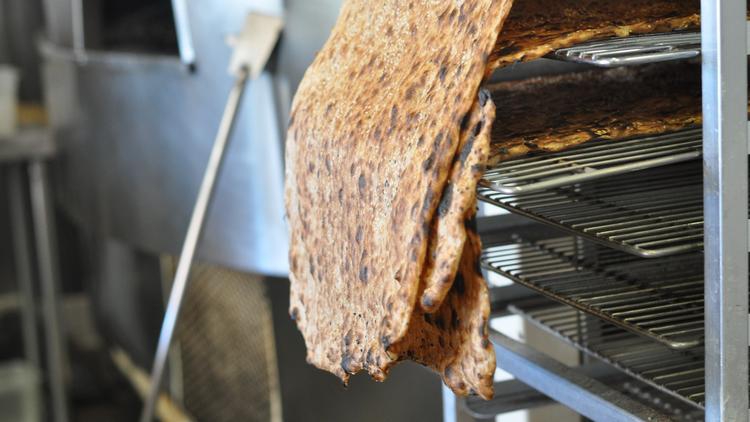Tuesday 3 November 2015 - 14:28
Story Code : 187118
Where to find sangak, Persian flatbread, in L.A. How to stop eating it? No idea
It can be found at most Persian markets packaged in plastic and drooping lazily over the sides of shelves like an endless swath of delicious carbohydrates. But a strong case can be made for buying it at one of L.A.�s Persian bakeries, where it�s prepared fresh right in front of you or plucked from a drying rack where the sangak hangs like so much tanning leather or maybe slices of sea sponge.
Buying sangak at a place such as Naan Hut on Santa Monica Boulevard, in the Sawtelle neighborhood on the Westside, where it's baked in-house, also gives you a chance to see how much sangak individual patrons purchase -- though it goes stale after a couple of days, it freezes well, so customers will often take home five pieces, or sometimes 10.
You can also see how each portion of sangak is spread out onto a length of brown paper (in Iran, it�s wrapped in fabric) and folded into an �S� shape so the moist, still-warm bread doesn�t stick together.
According to Ramiro Garcia, one of Naan Hut�s heat-flushed counter men, sangak in Iran is traditionally baked over beds of small, blisteringly hot rocks. (The name means �pebbles.�) But here in the U.S., health authorities insist that concessions are made to things such as dental safety.
�Sometimes the rocks stick to the bread,� said Garcia, who then pantomimes biting down on something hard. �You could break a tooth.�
Instead, Naan Hut achieves sangak�s pockmarked, intermittently charred surface by way of a rotating, bumpily textured metal bed that sits tilted at an angle inside the bakery's enormous stainless steel oven, which was shipped from Iran via Canada and is heated to between 150 and 200 degrees Celsius. Using a wooden baker's peel, the wet dough is slid on top of the hot metal disc, which twirls until the bread is done, a process that takes just a few minutes.
On the Internet, debates about sangak in Los Angeles tend to be about which bakery makes it best -- Naan Hut or Woodland Hills� Asal Bakery and Kabob.
Though there is consensus that it is best eaten warm from the oven or a toaster, so that the outside is crispy while the inside is soft and chewy, there is a lot of back and forth about what to eat with sangak -- topped with tomato and feta cheese, served with the yogurt shallot dip known as mast-o-musir, or slathered with beurre blanc, etc.
There is regrettably, however, no thread explaining how to stop eating sangak once you get started, perhaps because it�s sort of impossible.
This article was written by Margy Rochlin for Los Angeles Times on Nov. 2, 2015.
# Tags











